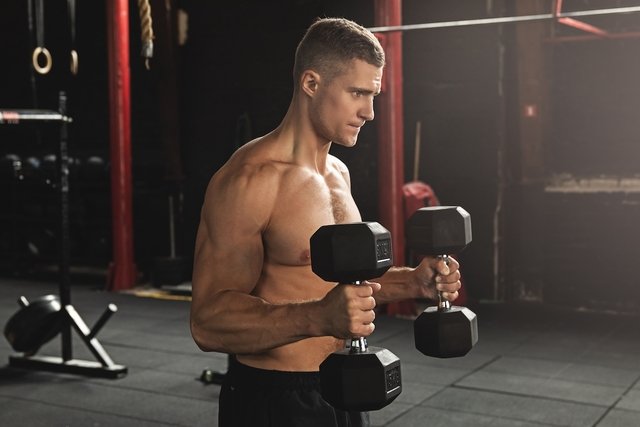The hammer curl is a resistance exercise that serves to maximize muscle mass gain or biceps hypertrophy, in addition to strengthening the forearms and improving grip strength.
This exercise is a good option to include in the training of superiors, and can be done sitting or standing, using dumbbells, on a pulley or with a bar, and because it has a neutral grip, it has the advantage of putting less strain on the wrists than the curl. direct.
The hammer curl must be done with the guidance of a physical education professional who can indicate the variation of this exercise, in addition to being able to advise the appropriate weight to perform it, according to the physical conditions of each person and the objective of the training.

What is it for
The barbell curl serves to increase muscle mass and the size of the biceps brachii located in the upper part of the arm and shoulder, leaving it firmer and more defined.
Furthermore, this exercise also helps to strengthen the forearms, as it also works the brachioradialis muscle, and can be done together with other arm training exercises. See other exercises for arm training.
The barbell curl also helps to improve grip strength, which is the hands’ ability to perform activities that require effort.
How to do hammer curls with dumbbells
To do the hammer curl with dumbbells, you must:
- Stand and hold a dumbbell in each hand with your palms facing inwardwith arms down in line with the body;
- Keep your back straightthe abdomen contracted and the elbows resting on the sides of the body throughout the movement;
- Flex your elbowsraising your forearms until the weights are at shoulder height;
- Do not move your wristsnor the shoulders during flexion, to avoid causing injuries;
- Lower your arms slowly to the starting position;
- Do 2 to 4 sets of 8 to 15 repetitions eachwith 60 to 90 seconds of rest between sets, as advised by the physical education professional.
When performing the hammer curl, it is important to inhale when the arms are in the starting position and exhale when flexing the elbows.
1. Hammer curl with rope
The hammer thread with rope is done on the pulley, and is also called hammer thread on the pulley or hammer cross thread on the pulley.
To do the hammer curl with rope, you must place the weights on the bar recommended by the physical education professional and place the safety hooks on the weights to avoid accidents.
Then, standing facing the device, hold the end of the rope, keeping your elbows at your sides and pull the rope towards your torso until your hands are close to your shoulders.
When raising your forearms, you must open the rope and close it when lowering your forearms.
2. Alternating hammer curls
The alternating hammer curl is done using dumbbells, one in each hand, but you must raise your arms one at a time in an alternating manner.
3. Barbell hammer curl
The hammer curl with bar is made with an H-shaped bar in which the weight is placed at the ends of the bar and the safety hook to prevent the weights from coming loose.
The movement of this type of hammer curl is the same as the hammer curl with dumbbells or hammer curl with rope, since the movement of the forearm is done simultaneously.
4. Unilateral martellus thread
The unilateral hammer curl is done by lifting the dumbbell in just one arm, repeating the movements in just one arm and then doing it with the other arm.
5. Simultaneous hammer curl
The simultaneous hammer curl is done by lifting the weights at the same time with both arms.
6. Scott hammer curl
The Scott hammer curl is done sitting on a device called Scott that has a cushion to support the elbows.
Care when doing hammer curls
Some precautions are important when doing hammer curls, such as:
- Always keep your spine straight and aligned and your head and neck straight and aligned with your spine;
- Always keep your elbows resting on your sides and your hands facing inward;
- Keep your abdomen contracted at all times;
- Inhale while raising your forearms towards your torso;
- Exhale when lowering your arms;
- Keep your feet always supported on the floor, feeling the weight on your heels;
- Avoid making quick, forced movements.
It is important to always check the correct exercise posture and the appropriate amount of weights, and therefore the hammer curl must be done with the guidance of a physical education professional in order to avoid injuries.
What is the difference between hammer curls and barbell curls?
Both hammer curls and barbell curls work the biceps brachii muscle, the main difference being the position of the hands and the recruitment of different muscle fibers.
In the hammer curl, the wrists have a neutral grip, that is, the hands are facing inwards, facing each other, while in the barbell curl, the hands are facing upwards.
This allows different muscle fibers to be activated more intensely, with hammer curls focusing on the longer head of the biceps and in barbell curls the shorter head of the biceps. See how to do the barbell curl.

Sign up for our newsletter and stay up to date with exclusive news
that can transform your routine!
Warning: Undefined array key "title" in /home/storelat/public_html/wp-content/plugins/link-whisper-premium/templates/frontend/related-posts.php on line 12
Warning: Undefined array key "title_tag" in /home/storelat/public_html/wp-content/plugins/link-whisper-premium/templates/frontend/related-posts.php on line 13



